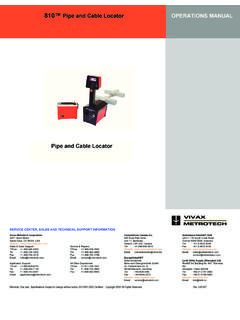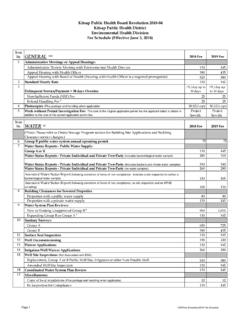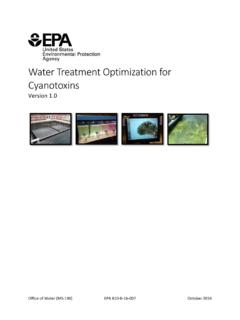Transcription of PWM-dimmable single channel LED driver with integrated ...
1 This is information on a product in full production. June 2014 DocID025575 Rev 31/26 LED6001 PWM-dimmable single channel LED driver with integrated boostcontrollerDatasheet - production dataFeatures Switching controller section V to 36 V input voltage range Very low shutdown current: ISHDN < 10 A Internal +5 V LDO for gate driver supply Internal + V LDO for device supply Fixed frequency peak current mode control Adjustable (100 kHz to 1 MHz) switching frequency External synchronization for multi-device applications High performance external MOSFET driver Cycle-by-cycle external MOSFET OCP Fixed internal soft-start Programmable output OVP Boost, buck-boost and SEPIC topologies supported Thermal shutdown with autorestart Output short-circuit detection LED control section Up to 60 V output voltage Constant current control loop High-side output current sensing circuitry 30 to 300 mV differential sensing voltage 4% output current reference accuracy Output overcurrent protection Sensing resistor failure protection PWM dimming with auxiliary series switch Analog dimmingApplications Indoor and architectural LED lighting Emergency LED lighting Off-grid LED street lighting White goods Gaming/gambling machines DescriptionThe LED6001 device is a LED driver that combines a boost controller and a high-side current sensing circuitry optimized for driving one string of high-brightness LEDs.
2 The device is compatible with multiple topologies such as boost, SEPIC and floating load buck-boost. The brightness of the LEDs can be controlled through PWM dimming and analog dimming (10:1 ratio) by means of two independent pins. Enhanced PWM dimming can be obtained thanks to a MOSFET in series with the LED string and directly driven by a dedicated high-side current sensing, in combination with a P- channel MOSFET, provides an effective protection in case the positive terminal of the LED string is shorted to ground. The high precision current sensing circuitry allows a LED current regulation reference within 4% accuracy over the whole temperature range and production fault output (open-drain) informs the host system about faulty conditions: device overtemperature, output overvoltage (disconnected LED string) and LED overcurrent. HTSSOP-16 Table 1. Device summaryOrder codePackagePackagingLED6001 HTSSOP-16 (exposed pad)TubeLED6001 TRTape and Rev 3 Contents1 Typical application circuit.
3 32 Pin function .. 43 Block diagram .. 64 Absolute maximum ratings .. 75 Recommended operating conditions .. 86 Electrical characteristics .. 97 Device description .. supply .. controller .. on and power-down sequences .. controller operation .. converter stability and slope compensation .. frequency oscillator and external synchronization .. current regulation and brightness control .. protections .. regulators undervoltage lockout .. switch overcurrent .. overvoltage and OVFB pin disconnection .. rail disconnection detection or output short-circuit to ground .. shutdown .. 228 Package information .. 239 Revision history .. 25 DocID025575 Rev 33/26 LED6001 Typical application circuit261 Typical application circuitFigure 1. Basic application circuit schematic (boost topology)/(' 9'59,1*$7(&6163*1'9)%39)%13:0229)%/'2 )$8/7$',06*1'3:0,)6:9,1&,1&28759)%5*$7(4 6:4',056165)6:5&203&/'2 &9'5&&203929)%929)%928756/23(529)%+529)% /9/'2 9/'2 9/'2 /%2267'):$0 Pin functionLED60014/26 DocID025575 Rev 32 Pin functionFigure 2.
4 Pin connection (through top view)$0 9 3:0,)6:;)$8/7/'2 6*1'&203$',029)%9)%39)%19,19'5*$7(3*1'&6 163:02 DocID025575 Rev 35/26 LED6001 Pin function26 Table 2. Pin description enable and PWM dimming control input. 2 FSWS witching frequency setting. A resistor between this pin and SGND sets the desired switching frequency. This pin is also used as synchronization input. If tied high ( connected to LDO3 pin) a 600 kHz switching frequency is indicator, open-drain output. This pin is tied low by the device in case of faulty condition. See Section on page 20 for V linear regulator output and device supply. Connect a 1 F (typ.) bypass MLCC between this pin and SGND as close as possible to the ground. Return for analog circuitry. All setting components must refer to this grounding pin. 6 COMPB oost controller loop compensation. A simple RC series must be connected between this pin and SGND for proper loop compensation.
5 See Section on page 14 for dimming control input. The current at the output is linearly controlled by the voltage applied to this pin ( V to V). When the device is set to operate in standalone mode, a partition of the LDO3 voltage must be applied to this pin through a resistor overvoltage protection feedback input. Connect to the central tap of a resistor divider at the Boost controller power switch current sensing input. Connect to the source of the external power MOSFET for proper switch overcurrent dimming control output. This pin provides a PWM output signal (in phase with the one applied to the PWMI pin) for direct control of a dimming N- channel ground. Return for the VDR linear regulator and the power switch gate drivers. Also used as reference for the power MOSFET current sensing circuitry. Connect to ground as close as possible to the quiet terminal of the power switch sensing switch gate driver output.
6 Connect to the gate of the power MOSFET through a small value V linear regulator output and gate driver supply. Connect a 1 F (typ.) bypass MLCC between this pin and PGND as close as possible to the voltage input. Connect this pin to the supply power rail. A 1 F (typ.) bypass MLCC must be connected between this pin and PGND as close as possible to the chip. 15 VFBNO utput current differential sensing input, negative terminal. Connect to the hot terminal (load side) of the high-side sensing current differential sensing input, positive terminal. Connect to the quiet terminal (output capacitor side) of the high-side sensing pad. Connect to a suitable ground plane area in order to ensure proper heat dissipation. Electrically connected to PGND and diagramLED60016/26 DocID025575 Rev 33 Block diagramFigure 3. Simplified block diagram/'2 )6:3:0,;)$8/7&2033*1'&6169,16\QF GHWHFWRU26&89/2 GHWHFWRU 9 /'25 DPS JHQHUDWRU&XUUHQW VHQVLQJ6 RIW VWDUW %RRVW FRQYHUWHUFRQWURO ORJLF B*$7(B $',0 929329)%9)%39)%19'5 9 /'2&RQWURO ORJLF3:026*1' BJP 2 XWSXW FXUUHQW VHWWLQJ3:0 GHWHFWRU3 RZHU GRZQ ZDWFKGRJ WLPHU)DXOW PDQDJHPHQW(1(19'53*1'(17 KHUPDO SURWHFWLRQ P9 P96 ORSH FRPSHQVDWLRQ)HHGEDFN RXWSXW GLVFRQQHFWLRQ DQG RYHUORDG GHWHFWLRQ$0 DocID025575 Rev 37/26 LED6001 Absolute maximum ratings264 Absolute maximum ratings Table 3.
7 Absolute maximum pin voltageVIN to SGND40 VVFBP and VFBN to SGND65 VDR to to , CSNS and OVFB to to , FSW, ADIM and GATE to and PWMO to ESD susceptibilityJEDEC JS001 All pins-20002000 VIN, VFBP, VFBN and ADIM ESD susceptibilityVIN, VFBP, VFBN, ADIM to SGND-40004000 CDM ESD resistivity to SGND ANSI/ESD pins-750750 Non-corner pins-500500 Table 4. Thermal ,OPOperating junction temperature-40150 CTSTGS torage temperature range-50150 TSHDNT hermal shutdown threshold150160175 Thermal shutdown hysteresis20 XFAULT release hysteresis40 Rth,JA(1)Junction to ambient thermal resistance1s0p55 C/W2s2p45 Rth,JCJunction to case thermal resistance371. The device mounted on a standard JESD51-5 test operating conditionsLED60018/26 DocID025575 Rev 35 Recommended operating conditionsTable 5. Recommended operating UnitDC characteristicsVVINS upply input voltage pin Input voltage rangeVDR and VIN shorted input common mode voltage input differential mode voltage rangeVFBP to VFBN30300mVAC characteristics fswSwitching frequency1001000kHzfPWMID imming ,enMinimum PWMI pulse duration for device enable (turn on)PWMI input, fSW = 800 kHz100 stPWMI,dimMinimum dimming on-timePWMI input, fSW = 1 MHz6 sDocID025575 Rev 39/26 LED6001 Electrical characteristics266 Electrical characteristicsVIN = 12 V, VVFBP = 12 V, VVFBN = 12 V and TJ =- 40 C to 125 C if not otherwise specified.
8 Table 6. Electrical characteristicsSymbolParameterConditions Min. Typ. Max. UnitSupply sectionVVINS upply voltage turn on turn off pull-down resistorPMWI at V350570810k tSHDNPWMI low to shutdown mode delay 101522mstSTARTS tart-up time CLDO3 = CVDR = 470 nF100170 V LDO output voltage6 V VIN 36 V, ILDO3 = mA, PWMI V LDO line regulationILDO3 = 20 mA, PWMI high 6 V VIN 36 V LDO load regulationVIN = 6 V, PWMI mA ILDO3 20 mA90100 VLDO3,ONLDO3 undervoltage lockout upper threshold ,OFFLDO3 undervoltage lockout lower undervoltage lockout V LDO current limitVLDO3 = V303846mAVVDR5 V LDO output voltage6 V VIN 36 VIVDR = mA, PWMI V LDO line regulationIVDR = 40 mA, PWMI high 6 V VIN 36 V1040mV5 V LDO load regulationVIN = 6 V, PWMI high mA IVDR 40 mA1202005 V LDO dropout voltageIVDR = 25 mA, VVIN = V150300 VVDR,ONVDR undervoltage lockout upper threshold ,OFFVDR undervoltage lockout lower undervoltage lockout hysteresis201503005 V LDO current limitVVDR = V5075100mAElectrical characteristicsLED600110/26 DocID025575 Rev 3 Power consumptionIVIN,SHDNS hutdown current VIN = 16 V, PWMI low, -40 C TJ 25 C1410 AVIN = 16 V, PWMI low, 25 C TJ 125 C1925 IVIN,QQuiescent currentVIN = 16 V, PWMI to LDO3, -40 C TJ 125 C switching ,ON Operating currentVIN = 16 V, PWMI high, fSW = 200 kHz, CL = nF57 Boost controllertON,minMinimum switching on-timePulse skipping mode140180nsKFSWS witching frequency constantRFSW = 250 k 455055 MHz k fSWAdjustable switching frequencyRFSW = 500 k 90100110kHzRFSW = 250 k 180200220 RFSW = 50 k 9001000 1100 Fixed switching frequencyFSW pin high (LDO3)
9 500600700 Synchronization signal frequency capture rangetCLK,H = 250 ns, VCLK,L = V, VCLK,H = V 1001000 FSW synchronization input high levelfCLK = 100 kHz to 1 MHz, tCLK,H = 250 synchronization input low input high level pulse widthfCLK = 100 kHz to 1 MHz, VCLK,L = V, VCLK,H = V250nsRGATEP ower switch gate driver output resistancePull-up36 Pull-down13tr,GATEP ower switch gate driver rise time (20 to 80%)VVDR = 5 V, CL = nF1530nstf,GATEP ower switch gate driver fall time (80 to20%)714tSSInternal soft-start compensation constant357A/sVCSNS,OCPP ower switch OCP detection thresholdCSNS pin to PGND300360400mVTable 6. Electrical characteristics (continued)SymbolParameterConditionsMin. Typ. Max. UnitDocID025575 Rev 311/26 LED6001 Electrical characteristics26 Output current sensing sectionVFBF eedback voltage (VVFBP - VVFBN differential current sensing voltage) VADIM = V203040mVVADIM = V110120130 VADIM = V280300304 Feedback reference voltage accuracyVADIM to LDO3288300308 VADIM,OFFADIM pin voltage turn off threshold260270280 ADIM pin voltage turn off hysteresis51020 IVFBPF eedback positive input currentVVFBP = VVVFBN = V-32-25-18 AIVFBNF eedback negative input currentVVFBP = VVVFBN = V-7-5-4 PWM dimming controlRPWMOPWMO gate driver output resistancePull-up1422 Pull-down38tr,PWMOPWMO gate driver rise time (20 to 80%)VVDR = 5 V, CL = nF50120nstf,PWMOPWMO gate driver fall time (80 to 20%)
10 3060 Fault management sectionVOVFB,thXFAULT output low levelIXFAULT = 4 high level leakage currentVXFAULT = 5 V14 AOVFB input overvoltage detection input overvoltage detection hysteresis70100130mVOVFB pull-up currentVOVFB = 1 AOpen load/VFBP pin disconnection detection threshold (differential)(VVFBP - VVFBN)-190 -120-80mVOverload /VFBN pin disconnection detection threshold (differential)550600650 VFBx undervoltage detection thresholdVVFBx respect to 6. Electrical characteristics (continued)SymbolParameterConditionsMin. Typ. Max. UnitDevice descriptionLED600112/26 DocID025575 Rev 37 Device descriptionThe LED6001 device is a LED driver that integrates a boost controller, a high-side current sensing circuitry and a gate driver for an external dimming switch. It has been specifically designed for driving a single string of high-brightness LEDs. The device can support boost, floating buck-boost and SEPIC topologies in order to cover most of applications.
















